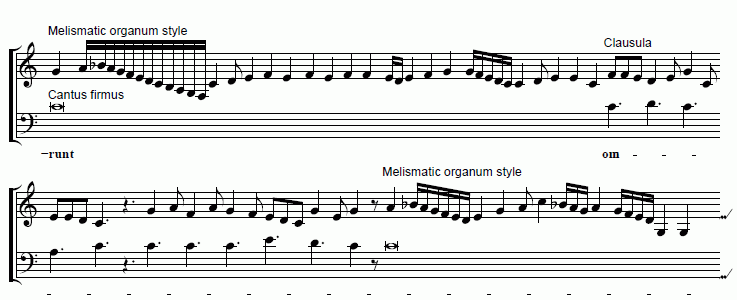| Clausula or discantus style The medieval technique of polyphonic composition (two-, three- or four-part) of the 12th and 13th century can be summarized as successive layers of melodic lines. The two-part organum, the so called organum duplum, has the typical design of the florid or melismatic organum: the lowest voice, based on the chant (hence: tenor or cantus firmus), is composed as a slow moving melody (long notes) and the upper voice, orginally improvised, later rhythmically organized by modes, contains small note values and is relatively fast moving. However, it has also a section in which the notes of the tenor became shorter. This separate, rhythmically bound section is called 'clausula'. The style of this section can be described as 'clausula'-style or a 'discantus'-style. A nice example is 'Viderunt omnes' of Leonin (12th century). 
When to write a clausula? Some scholars claim that the medieval composer selected the original melismatic passage of the chant as appropriate for a clausula. Example: the melisma on the syllabe 'om' of 'omnes' lead to the clausula in Leonin's Viderunt Omnes. 
Motet developed from clausula The Motet came into being when the clausula sections were detached and expanded, and words (mots) were added to the upper voice (hence: motetus). Note that the Motet became the most popular form of the Middle Ages (as the fugue in the Baroque). Remark Note that the terms clausula and discantus are not consistent. Clausula means in later periods (renaissance, baroque) 'cadence'. Discantus can mean upper voice. (English) Discantus or Descant can also refer to a composition in a conductus style. |